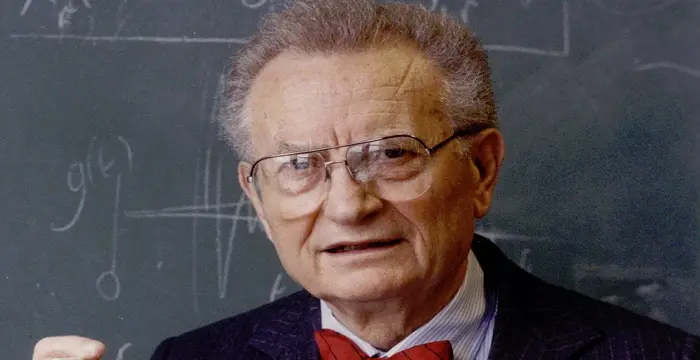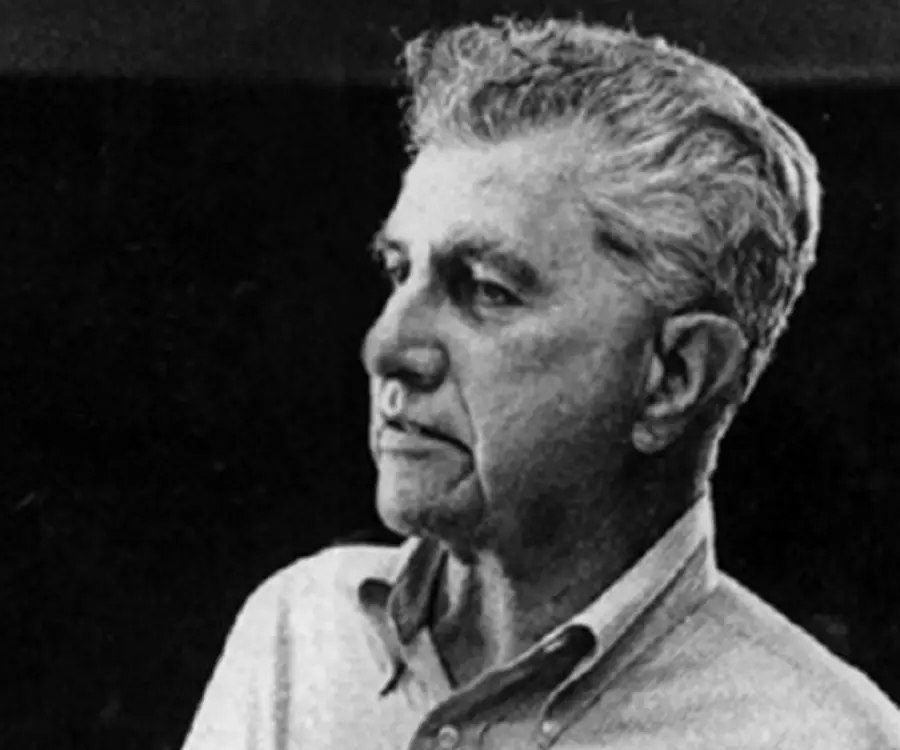
Merton H. Miller - Intellectuals & Academics, Birthday and Childhood
Merton H. Miller's Personal Details
Merton H
| Information | Detail |
|---|---|
| Birthday | May 16, 1923 |
| Died on | June 3, 2000 |
| Nationality | American |
| Famous | Intellectuals & Academics, Economists |
| City/State | Illinois |
| Spouses | Eleanor Miller (d. 1969), Katherine Miller |
| Birth Place | Chicago, Illinois, United States |
| Gender | Male |
| Father | Joel Miller |
| Mother | Sylvia Miller |
| Sun Sign | Taurus |
| Born in | Chicago, Illinois, United States |
| Famous as | Economist |
| Died at Age | 77 |
// Famous Economists
Bertil Gotthard Ohlin
Bertil Gotthard Ohlin was a famous Swedish economist. This biography profiles his childhood, family life & achievements.
Emily Greene Balch
Emily Greene Balch was an American economist, sociologist and pacifist who won the 1946 Nobel Peace Prize. This biography of Emily Greene Balch provides detailed information about her childhood, life, achievements, works & timeline.
Paul Samuelson
Nobel laureate Paul Anthony Samuelson is referred to as the ‘Father of Modern Economics’. This biography profiles his childhood, life, career, achievements and interesting facts about him.
Merton H. Miller's photo
Who is Merton H. Miller?
Merton Howard Miller was an American economist known for his contribution to the theory of finance. Born into a Jewish emigrant family in the early 1920s, most of his formative years were spent during the Great Depression. Despite the odds, his parents made sure he got the best education. An alumnus of the Boston Latin School and Harvard University, he spent the Second World War years working for the U.S. Treasury Department. Later he earned his PhD from John Hopkins University and after a one-year stint at the London School of Economics, he joined Carnegie Institute of Technology at Pittsburg. There he met Franco Modigliani and with him he co-wrote the Modigliani-Miller theorem, which opened a new vista in the field of corporate finance. Thereafter, he joined the faculty of the University of Chicago, where he continued working on corporate finance. However, from the early 1980s, his research interest shifted to the regulatory as well as financial problems faced by the financial services industry. Ten years before his death from cancer, while he was still a professor at Chicago University, Miller was awarded a share of the Nobel Memorial Prize in Economic Sciences for his “pioneering work in the theory of financial economics”.
// Famous Intellectuals & Academics
Bertil Gotthard Ohlin
Bertil Gotthard Ohlin was a famous Swedish economist. This biography profiles his childhood, family life & achievements.
Emily Greene Balch
Emily Greene Balch was an American economist, sociologist and pacifist who won the 1946 Nobel Peace Prize. This biography of Emily Greene Balch provides detailed information about her childhood, life, achievements, works & timeline.
Martin Buber
One of the greatest philosophers to have ever walked on earth, Martin Buber contributions to philosophy is a long-standing one. Explore all about his profile, childhood, life and timeline here.
Childhood & Early Years
Merton Howard Miller was born on May 16, 1923 in Boston, Massachusetts. His father, Joel Miller, was a second generation Jewish emigrant, whose cigar-making family emigrated from England in the middle of the nineteenth century. He was an established attorney-at-law, later representing his state in Republican National Convention.
Soon after his marriage to Sylvia Francis Starr, a Yiddish Russian, who had come to the USA with her family at the age of sixteen, Joel started publishing a local newspaper, mainly to supplement his income.
While reporting certain incidents involving judges, Joel Miller became interested in law. Already an AB from Harvard University, he began to study law at Suffolk Law School, finally establishing his own legal practice in 1929, just before the onset of the Great Depression. He was then thirty-five years old.
Merton, born in the Roaring Twenties, was his parents’ only child. His early years were passed in Dorchester, a working-class area in Boston. Later as the Great Depression set in, he watched people suffering all around.
However, Joel had by then set up his practice. Therefore, he was able to secure good education for his son, enrolling him at the prestigious Boston Latin School; a public school established in 1635 for educating the sons of the city’s elite.
Merton graduated from BSL in 1940 and then followed his father’s footstep to enter Harvard University. However, unlike his father, his main interest was in economics. He completed his course within three years, graduating magna cum laude in 1943.
However, he received his artium baccalaureus (equivalent to Bachelor of Arts in other universities), in 1944. Meanwhile, he was called for war duty, but because he had defect in one ear, he was assigned to the Division of Tax Research of the U.S. Treasury Department as his war service.
Sometime later, he joined the Division of Research and Statistics of the Board of Governors of the Federal Reserve System at Washington. Concurrently, he started taking evening classes in nearby George Washington University, which he hoped would help him to earn his doctoral degree.
By 1949, Merton Miller realized that it was not possible to pay equal attention to his work and study and that he would have to make a choice. To his parents’ disappointment, who wanted him to join the Harvard University, he chose Johns Hopkins University in Baltimore.
One of the reasons why he chose Hopkins was that it also offered him a teaching opportunity, which would provide him a reasonable income. Moreover, though it was mostly known for its medical courses, it was also developing a strong financial program.
Miller was also attracted by the fact that joining Hopkins would enable him to have Fritz Machlup, an Austrian-American economist, credited with popularizing the concept of the information society, as his doctoral guide. Working with Machlup, he received his PhD in 1952.
Joining Carnegie Institute of Technology
In 1952, soon after receiving his PhD, Merton Miller was appointed as the Visiting Assistant Lecturer at the London School of Economics for the 1952-53 session. Immediately on his return in 1953, he joined the Graduate School of Industrial Administration in Pittsburg, Pennsylvania.
Located in the campus of the Carnegie Institute of Technology (now Carnegie-Mellon University), it was one of the most influential research-oriented business schools in the USA. Here he met Franco Modigliani and began collaborating with him in the area of corporate finance.
According to some sources, both Miller and Modigliani were assigned to teach corporate finance. However, none of them had any knowledge about optimal capital structure of a firm. Therefore, they began to read the available literature diligently and were surprised to find that there was no unified or accepted principle on the subject.
Soon they started working on it, looking at the problem from different directions. In 1958, they jointly published their first paper, ‘The Cost of Capital, Corporate Finance and the Theory of Investment’ in ‘American Economic Review.’ It later became known as Modigliani-Miller theorem or M&M theorem.
Thereafter, they continued collaborating on the same subject, jointly publishing a number of papers on corporate finance. Among them, the most significant was ‘Dividend Policy, Growth, and the Valuation of Shares’. Published in 1961, the work extended the basic results of their earlier work and showed that, given investment decisions, dividend policy is also irrelevant.
At the University of Chicago
Also in 1961, Merton Miller moved to the Graduate School of Business at the University of Chicago as a faculty member while Modigliani joined MIT in 1962. In spite of that, they continued collaborating on several other issues until the mid-1960s.
In 1966, Miller moved to Belgium for a one-year visiting professorship at the University of Louvain. Returning to the University of Chicago in 1967, he continued to work on corporate finance. Sometime now, he was appointed the R. McCormick Distinguished Service Professor of Finance.
Meanwhile in 1972, working with his colleague Eugene Fama, he further developed the work he had started with Modigliani and co-wrote ‘The Theory of Finance’. Incidentally, Fama was his first doctoral student.
From the early 1980s, his focus began to shift away from capital finance. In 1983, he became the Public Director of Chicago Board of Trade, a position he held till 1985. Thereafter from 1990, he became the Public Director of the Chicago Mercantile Exchange, holding the position till his death.
As a result of his involvements with the financial exchanges, he now became more interested in the problems faced by the financial services industry. His work now focused on the economic and regulatory problems faced by the securities and options exchanges.
In spite of his heavy schedule, he collaborated with others to write eight books. Among them, ‘Macroeconomics: A Neoclassical Introduction’, which he co-wrote with Charles W. Upton, is highly appreciated as a textbook. Published in 1986, the work was first to highlight the importance of neoclassical growth model.
Next in 1991, he published two other important works; ‘Merton Miller on Derivatives’ and ‘Financial Innovations and Market Volatility’. These works offer insights into the state of the contemporary market and also on the future of investment vehicles like stocks, bonds, and securities.
In 1993, Merton Miller officially retired from his position as a professor at the University of Chicago. Thereafter, he remained as a Professor Emirates and continued teaching for several more years until his death in 2002.
Major Works
Merton Miller is best remembered for his pioneering research which helped to revolutionize corporate financial practices. The Modigliani-Miller theorem, which he co-authored with Franco Modigliani, formed the basis of modern thinking in capital structure. They established that there is nothing called the right debt ratio. According to the theory, corporate managers should try to maximize corporate net wealth and minimize tax liability, allowing the debt ratio chips to fall wherever they choose to fall.
Awards & Achievements
In 1975, he became a fellow of the Econometric Society. He was also attached to the American Academy of Arts and Sciences, American Economic Association and American Finance Association.
In 1976, he became the President of the American Finance Association.
In 1990 Merton H. Miller was awarded the Sveriges Riksbank Prize in Economic Sciences in Memory of Alfred Nobel jointly with Harry M. Markowitz and William F. Sharpe “for their pioneering work in the theory of financial economics.”
Personal Life & Legacy
In 1943, soon after graduating from the Harvard University, Merton Miller married Eleanor Natalie Cohen, also from Boston. They had three daughters; Pamela, born in 1952; Margot in 1955 and Louise in 1958. His wife died in 1969.
He later married Katherine Miller, but did not have any further children. While they mostly lived in their townhouse in Hyde Park, they also had a country retreat in Woodstock, where they spent their weekends, tending the garden. He was also fond of football and was a supporter of Chicago Bears.
On June 3, 2000, Miller died in his home in Chicago from lymphoma at the age of seventy seven. He was survived by his second wife Katherine, three daughters and two grandsons, Andrew and Eric.
// Famous American peoples
Wentworth Miller
Wentworth Miller is an American actor and screenwriter who achieved recognition for his role in the TV series ‘Prison Break’.
Jason Simpson
Jason Simpson is the son of former NFL running back, broadcaster and actor O. J. Simpson. Check out this biography to know about his childhood, family, life, and little known facts about him.
Melissa Brim
Melissa Brim is the ex-girlfriend of former professional boxer Floyd Mayweather Jr. Check out this biography to know about her birthday, childhood, family life, achievements and fun facts about her.
Merton H. Miller's awards
| Year | Name | Award |
|---|---|---|
Other | ||
| 0 | 1990 - Nobel Memorial Prize in Economic Sciences | |
Merton H. Miller biography timelines
- // 1635However, Joel had by then set up his practice. Therefore, he was able to secure good education for his son, enrolling him at the prestigious Boston Latin School; a public school established in 1635 for educating the sons of the city’s elite.
- // 16th May 1923Merton Howard Miller was born on May 16, 1923 in Boston, Massachusetts. His father, Joel Miller, was a second generation Jewish emigrant, whose cigar-making family emigrated from England in the middle of the nineteenth century. He was an established attorney-at-law, later representing his state in Republican National Convention.
- // 1929While reporting certain incidents involving judges, Joel Miller became interested in law. Already an AB from Harvard University, he began to study law at Suffolk Law School, finally establishing his own legal practice in 1929, just before the onset of the Great Depression. He was then thirty-five years old.
- // 1940 To 1943Merton graduated from BSL in 1940 and then followed his father’s footstep to enter Harvard University. However, unlike his father, his main interest was in economics. He completed his course within three years, graduating magna cum laude in 1943.
- // 1944However, he received his artium baccalaureus (equivalent to Bachelor of Arts in other universities), in 1944. Meanwhile, he was called for war duty, but because he had defect in one ear, he was assigned to the Division of Tax Research of the U.S. Treasury Department as his war service.
- // 1949By 1949, Merton Miller realized that it was not possible to pay equal attention to his work and study and that he would have to make a choice. To his parents’ disappointment, who wanted him to join the Harvard University, he chose Johns Hopkins University in Baltimore.
- // 1952Miller was also attracted by the fact that joining Hopkins would enable him to have Fritz Machlup, an Austrian-American economist, credited with popularizing the concept of the information society, as his doctoral guide. Working with Machlup, he received his PhD in 1952.
- // 1958Soon they started working on it, looking at the problem from different directions. In 1958, they jointly published their first paper, ‘The Cost of Capital, Corporate Finance and the Theory of Investment’ in ‘American Economic Review.’ It later became known as Modigliani-Miller theorem or M&M theorem.
- // 1961Thereafter, they continued collaborating on the same subject, jointly publishing a number of papers on corporate finance. Among them, the most significant was ‘Dividend Policy, Growth, and the Valuation of Shares’. Published in 1961, the work extended the basic results of their earlier work and showed that, given investment decisions, dividend policy is also irrelevant.
- // 1966 To 1967In 1966, Miller moved to Belgium for a one-year visiting professorship at the University of Louvain. Returning to the University of Chicago in 1967, he continued to work on corporate finance. Sometime now, he was appointed the R. McCormick Distinguished Service Professor of Finance.
- // 1972Meanwhile in 1972, working with his colleague Eugene Fama, he further developed the work he had started with Modigliani and co-wrote ‘The Theory of Finance’. Incidentally, Fama was his first doctoral student.
- // 1975In 1975, he became a fellow of the Econometric Society. He was also attached to the American Academy of Arts and Sciences, American Economic Association and American Finance Association.
- // 1976In 1976, he became the President of the American Finance Association.
- // 1986In spite of his heavy schedule, he collaborated with others to write eight books. Among them, ‘Macroeconomics: A Neoclassical Introduction’, which he co-wrote with Charles W. Upton, is highly appreciated as a textbook. Published in 1986, the work was first to highlight the importance of neoclassical growth model.
- // 1990In 1990 Merton H. Miller was awarded the Sveriges Riksbank Prize in Economic Sciences in Memory of Alfred Nobel jointly with Harry M. Markowitz and William F. Sharpe “for their pioneering work in the theory of financial economics.”
- // 1991Next in 1991, he published two other important works; ‘Merton Miller on Derivatives’ and ‘Financial Innovations and Market Volatility’. These works offer insights into the state of the contemporary market and also on the future of investment vehicles like stocks, bonds, and securities.
- // 1993 To 2002In 1993, Merton Miller officially retired from his position as a professor at the University of Chicago. Thereafter, he remained as a Professor Emirates and continued teaching for several more years until his death in 2002.
- // 3rd Jun 2000On June 3, 2000, Miller died in his home in Chicago from lymphoma at the age of seventy seven. He was survived by his second wife Katherine, three daughters and two grandsons, Andrew and Eric.
// Famous Taurus Celebrities peoples
Jason Simpson
Jason Simpson is the son of former NFL running back, broadcaster and actor O. J. Simpson. Check out this biography to know about his childhood, family, life, and little known facts about him.
Sophie Reade
Sophie Victoria Reade is a British model and reality show star. Let’s take a look at her family and personal life, including her age, birthday, boyfriends, and some interesting facts.
ASMR Aspen
ASMR Aspen is an American YouTuber. Check out this biography to know about her birthday, childhood, family life, achievements and fun facts about her.
Bertil Gotthard Ohlin
Bertil Gotthard Ohlin was a famous Swedish economist. This biography profiles his childhood, family life & achievements.
Josh Temple
Check out all that you wanted to know about Josh Temple (Slogoman), the famous British YouTube Personality; his birthday, his family and personal life, his girlfriends, fun trivia facts and more.
Aidan Prince
Aidan Prince is an American dancer, actor and vlogger. Let’s have a look at his family and personal life including age, date of birth, net worth, and fun facts.
Merton H. Miller's FAQ
What is Merton H. Miller birthday?
Merton H. Miller was born at 1923-05-16
When was Merton H. Miller died?
Merton H. Miller was died at 2000-06-03
Where was Merton H. Miller died?
Merton H. Miller was died in Chicago
Which age was Merton H. Miller died?
Merton H. Miller was died at age 77
Where is Merton H. Miller's birth place?
Merton H. Miller was born in Chicago, Illinois, United States
What is Merton H. Miller nationalities?
Merton H. Miller's nationalities is American
Who is Merton H. Miller spouses?
Merton H. Miller's spouses is Eleanor Miller (d. 1969), Katherine Miller
Who is Merton H. Miller's father?
Merton H. Miller's father is Joel Miller
Who is Merton H. Miller's mother?
Merton H. Miller's mother is Sylvia Miller
What is Merton H. Miller's sun sign?
Merton H. Miller is Taurus
How famous is Merton H. Miller?
Merton H. Miller is famouse as Economist











